1993 CHEVROLET ASTRO PASSENGER warning lights
[x] Cancel search: warning lightsPage 177 of 345
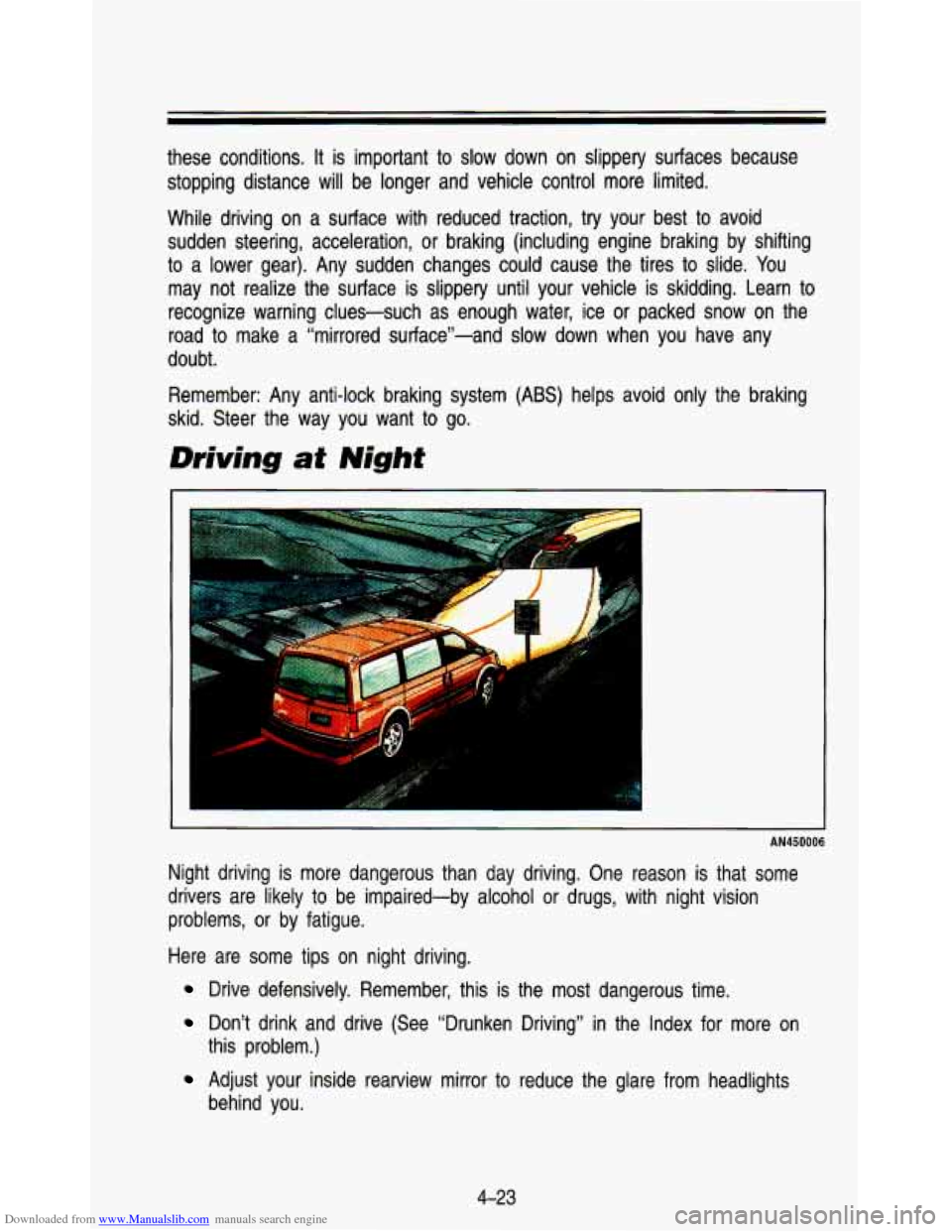
Downloaded from www.Manualslib.com manuals search engine these conditions. It is important to slow down on slippery surfaces because
stopping distance will be longer and vehicle control more limited.
While driving on a surface with reduced traction, try your best to avoid
sudden steering, acceleration, or braking (including engine brak\
ing by shifting
to a lower gear). Any sudden changes could cause the tires to s\
lide. You
may not realize the surface is slippery until your vehicle is skidding. Learn to
recognize warning clues-such as enough water, ice or packed sno\
w on the
road to make a “mirrored sutface”-and slow down when you have any\
doubt.
Remember: Any anti-lock braking system
(ABS) helps avoid only the braking
skid. Steer the way you want to go.
Driving at Night
AN450006
Night driving is more dangerous than day driving. One reason is that some
drivers are likely to be impaired-by alcohol or drugs, with night vision
problems, or by fatigue.
Here are some tips on night driving.
Drive defensively. Remember, this is the most dangerous time.
Don’t drink and drive (See “Drunken Driving” in the Index for more on
Adjust your inside rearview mirror to reduce the glare from he\
adlights
this problem.)
behind you.
4-23
Page 183 of 345
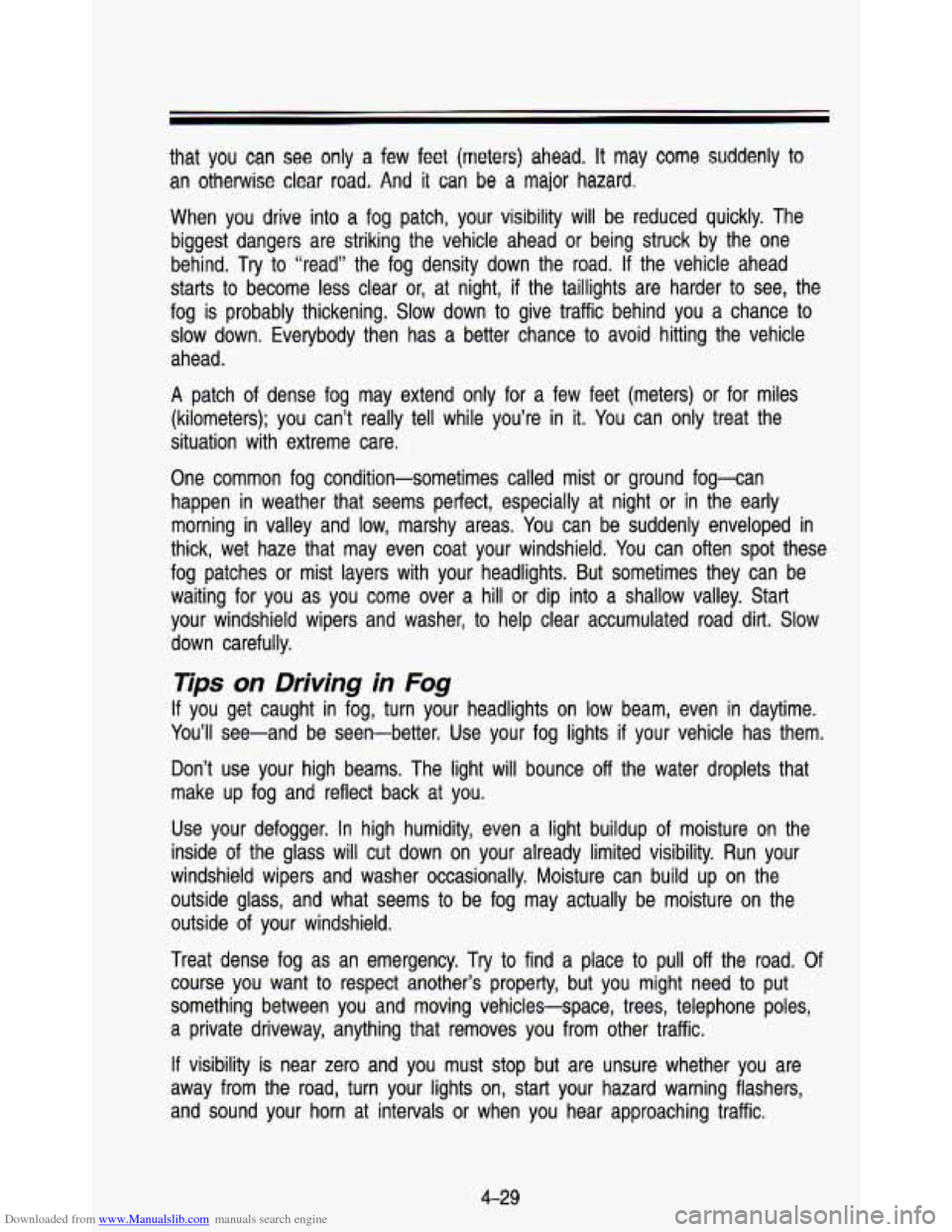
Downloaded from www.Manualslib.com manuals search engine that you can see only a few feet (meters) ahead. It may come suddenly to
an otherwise clear road. And it can be a major hazard.
When you drive into a fog patch, your visibility will be ieduced quickly. The
biggest dangers are striking the vehicle ahead
or being struck by the one
behind. Try
to “read” the fog density down the road. If the vehicle ahead
starts
to become less clear or, at night, if the taillights are harder to see, the
fog is probably thickening. Slow down to give traffic behind y\
ou a chance
to
slow down. Everybody then has a better chance to avoid hitting the vehicle
ahead.
A patch of dense fog may extend only for a few feet (meters) or for miles
(kilometers); you can’t really tell while you’re in
it. You can only treat the
situation with extreme care.
One common fog condition-sometimes called mist
or ground fog-can
happen in weather that seems perfect, especially at night
or in the early
morning in valley and low, marshy areas. You can be suddenly enveloped in
thick, wet haze that may even coat your windshield. You can often spot these
fog patches
or mist layers with your headlights. But sometimes they can be
waiting for you as you come over a hill
or dip into a shallow valley. Start
your windshield wipers and washer,
to help clear accumulated road dirt. Slow
down carefully.
Tips on Driving in Fog
If you get caught in fog, turn your headlights on low beam, even\
in daytime.
You’ll see-and be seen-better. Use your fog lights
if your vehicle has them.
Don’t use your high beams. The light will bounce
off the water droplets that
make up fog and reflect back at you.
Use your defogger. In high humidity, even a light buildup of moisture on the
inside
of the glass will cut down on your already limited visibility. Ru\
n your
windshield wipers and washer occasionally. Moisture can build up\
on the outside glass, and what seems to be fog may actually be moist\
ure on the
outside of your windshield.
Treat dense fog as an emergency.
Try to find a place to pull off the road. Of
course you want
to respect another’s property, but you might need to put
something between you and moving vehicles-space, trees, telephone poles,
a private driveway, anything that removes you from other traffi\
c.
If visibility is near zero and you must stop but are unsure whether you are
away from the road, turn your lights on, start your hazard warning flashers,
and sound your horn at intervals
or when you hear approaching traffic.
4-29
Page 186 of 345
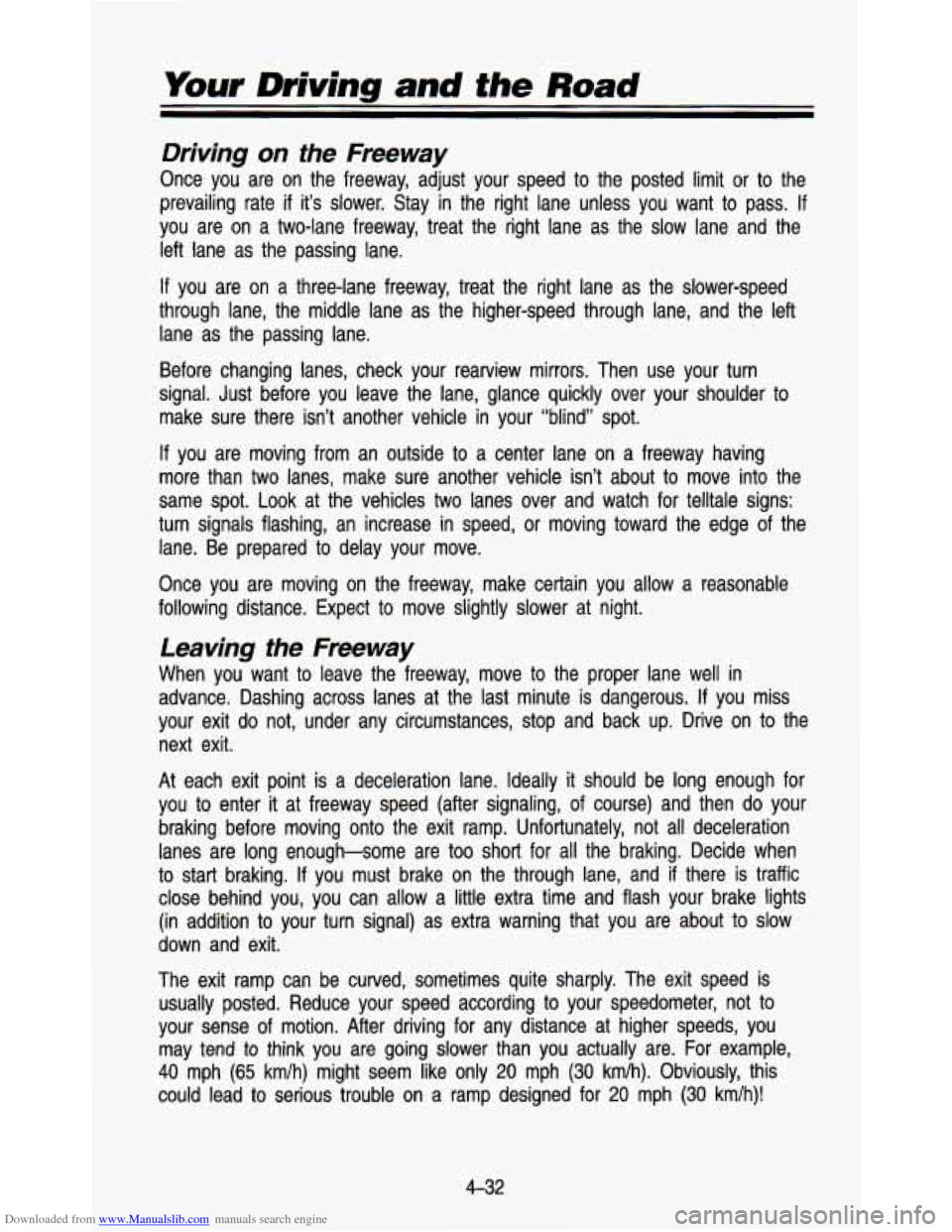
Downloaded from www.Manualslib.com manuals search engine Your Driving and the Road
Driving on the Freeway
Once you are on the freeway, adjust your speed to the posted \
limit or to the
prevailing rate
if it’s slower. Stay in the right lane unless you want to pass. If
you are on a two-lane freeway, treat the right lane as the s\
low lane and the
left lane as the passing lane.
If you are on a three-lane freeway, treat the right lane as the \
slower-speed
through lane, the middle lane as the higher-speed through lane,\
and the left lane as the passing lane.
Before changing lanes, check your rearview mirrors. Then use yo\
ur turn
signal. Just before you leave the lane, glance quickly over yo\
ur shoulder to make sure there isn’t another vehicle in your “blind” \
spot.
If you are moving from an outside to a center lane on a freeway\
having
more than two lanes, make sure another vehicle isn’t about \
to move into the
same spot. Look at the vehicles
two lanes over and watch for telltale signs:
turn signals flashing, an increase in speed, or moving toward \
the edge of the
lane. Be prepared to delay your move.
Once you are moving on the freeway, make certain you allow a \
reasonable
following distance. Expect to move slightly slower at night.
Leaving the Freeway
When you want to leave the freeway, move to the proper lane \
well in
advance. Dashing across lanes at the last minute is dangerous. \
If you miss
your exit do not, under any circumstances, stop and back up. \
Drive on to the
next exit.
At each exit point is a deceleration lane. Ideally
it should be long enough for
you to enter
it at freeway speed (after signaling, of course) and then do yo\
ur
braking before moving onto the exit ramp. Unfortunately, not al\
l deceleration
lanes are long enough-some are too short for all the braking. \
Decide when
to start braking.
If you must brake on the through lane, and if there is traffic
close behind you, you can allow a little extra time and flash\
your brake lights
(in addition to your turn signal) as extra warning that you \
are about
to slow
down and exit.
The exit ramp can be curved, sometimes quite sharply. The exit\
speed is usually posted. Reduce your speed according to your speedometer,\
not to
your sense of motion. After driving for any distance at higher\
speeds, you may tend
to think you are going slower than you actually are. For example,\
40 mph (65 km/h) might seem like only 20 mph (30 kmk). Obviously, this
could lead to serious trouble on
a ramp designed for 20 mph (30 kmlh)!
4-32
Page 206 of 345
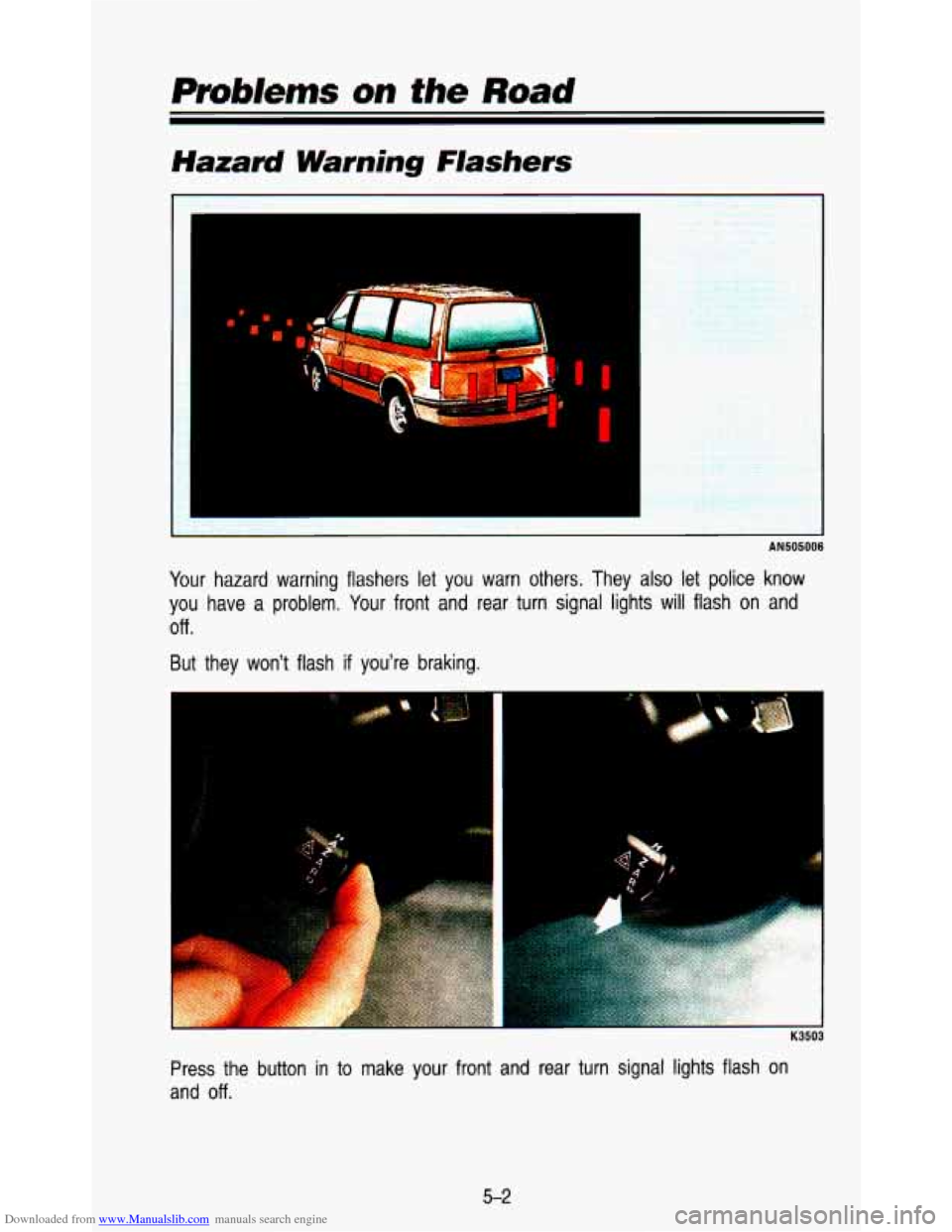
Downloaded from www.Manualslib.com manuals search engine Hazard Warning Flashers
---'-- I
r
1
AN505006
Your hazard warning flashers let you warn others. They also let police know
you have a problem. Your front and rear turn signal lights will flash on and
Off m
But they won't flash if you're braking.
I
...
Press the button in to make your front and rear turn signal lights flash on
and
off.
5-2
Page 302 of 345
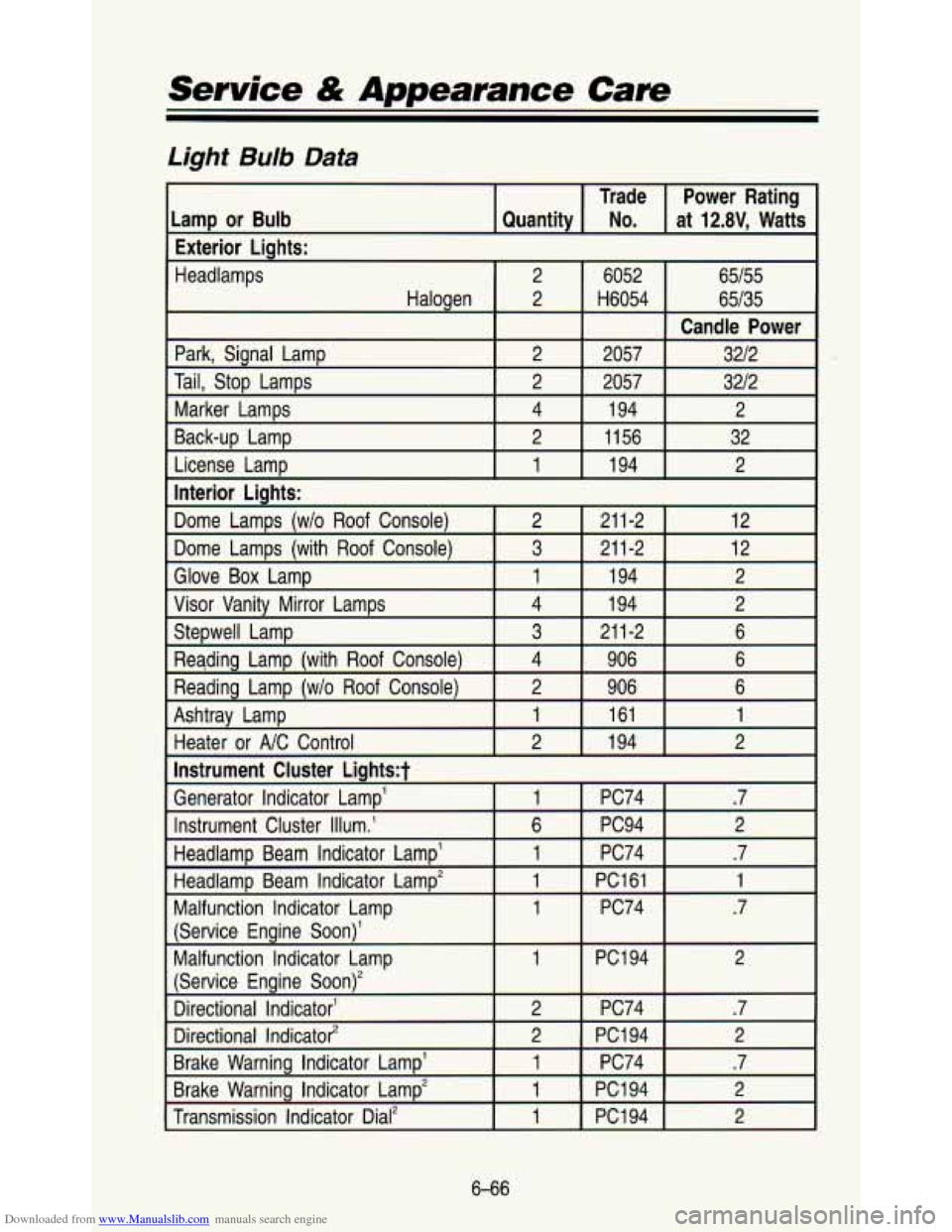
Downloaded from www.Manualslib.com manuals search engine Service & Appearance Care
Light Bulb Data
Trade at
12.8V, Watts No. Quantity
Lamp or Bulb Power Rating
Exterior Lights:
Headlamps 2
6052 65/55
Halogen 65/35
H6054
2
Park, Signal Lamp 2 2057 3212
Tail, Stop Lamps 2
2057
1 94
4
Marker Lamps 3212
12
211-2
3 Dome Lamps (with Roof Console) 12 211-2 2
Dome Lamps (w/o Roof Console)
Interior Lights:
2
194
1 License
Lamp 32
1156
2 Back-up Lamp 2
Candle Power
I Glove Box LamD Ill 194 I 2
I Visor Vanity Mirror Lamps I 4 I 194 I 2
Stepwell Lamp
2
Reading Lamp
(wlo Roof Console) 6 906
4
Reading Lamp (with
Roof Console) 6 21
1-2
3
2 1 94 2
Heater or NC Control
1 161 1 Ashtray Lamp 6 906
Instrument Cluster
Lightst
Generator Indicator Lamp’
2
PC94 6
Instrument Cluster Illum.’ .? PC74
1
Headlamp Beam Indicator Lamp’
2
PC1
94 2 Directional Indicato?
.? PC74
2
Directional Indicator‘
(Service Engine Soon)*
2 PC1 94 1
Malfunction Indicator Lamp
(Service
Engine Soon)’
.7 PC74 1 Malfunction Indicator Lamp
1 PC161 1 Headlamp Beam Indicator Lamp‘ .7
PC74
1
Brake Warning Indicator Lamp’
1
Brake Warning Indicator Lamp2 .7
PC74
1
2 PC1 94
1
Transmission Indicator Dial2
2 PC1 94
6-66
Page 339 of 345

Downloaded from www.Manualslib.com manuals search engine ..
.
E
Engine Block Heater
..................... 2.16. 3-9
Coolant
............................ 5.11. 6-26
Coolant Temperature Gage
...... 2-60
Cover
......................................... 6-1 5
Exhaust ............................ 2.24. 6-41
Fan Noise
.................................. 5-1 6
Identification
..................... 6.60. 6-64
Oil (See “Oil”) Overheating
................................. 5-8
Running While Parked
... 2.22. 2-25
Equipment. Add-on
...................... 6-44
Exhaust System
............................ 6-41
F
Finish Care
........................................... 6-56
Damage
..................................... 6-57
Automatic Transmission
............ 6-20
Brake
......................................... 6-32
Capacities
.................................. 6-64
Coolant
............................ 5.11. 6-26
Leak Check
............................... 6-34
Power Steering
......................... 6-30
Transfer Case
........................... 6-23
Windshield Washer
................... 6-31
Fog Lamps
.................................... 2-42
Four-wheel Antilock
..................... 4-1 5
Front Seats ..................................... 1-2
Fuel
................................................. 6-4
Gage
.......................................... 2-63
In Foreign Countries
................... 6-6
Regulator
................................... 2-1 5
Tank Capacity ........................... 6-65
Fuse Block
.................................... 6-63
Fuses and Circuit Breakers
......... 6-68
Fluid
Filling Your Tank
......................... 6-6
G
Gages
Fuel ............................................ 2-63 ....
Voltmeter .................................... 2-64
Gasolines for Cleaner Air
.............. 6-5
H
Hatch Release Switch .................. 2-27
Hazard Warning Flashers
.............. 5-2
Head Restraints
............................ 1-11
Headlights
...................................... 6-35
High Beams
..................... 2.66. 4-24
High-Low Beam
......................... 2-31
Reminder Light
.......................... 2-44
Heating System
.............................. 3-5
Fan Lever
.................................... 3-5
Rear
............................................. 3-7
Temperature Lever
...................... 3-5
Highway Hypnosis
........................ 4-34
Hitches Hood Block Heater.,
............................ 2-16
Function Lever
............................ 3-5
4-46
...........................................
Latches and Hinge ................... 6-40
Release
........................................ 6-8
Horn
............................................... 2-28
Hydroplaning
................................. 4-27
I
If You’re Stuck in Sand. Mud.
Ice or Snow
.............................. 5-32
Ignition Switch
............................... 2-13
Inflation-Tire Pressure
................... 6-45
Instrument Cluster
........................ 2-52
Standard
.................................... 2-55
Digital
......................................... 2-52
J
Jack Storage ................................. 5-18
Jump Starting
.................................. 5-3
9-3
Page 341 of 345
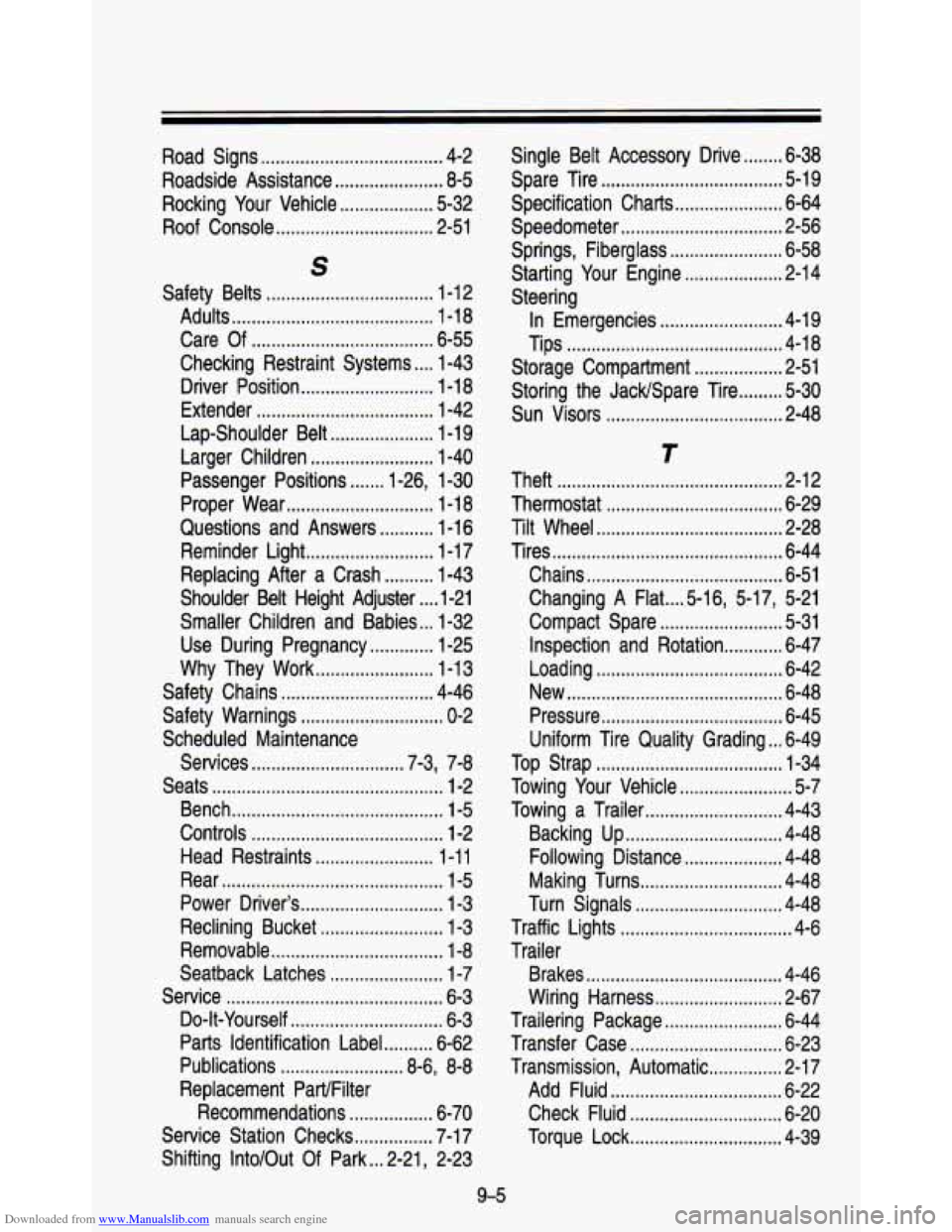
Downloaded from www.Manualslib.com manuals search engine Road Signs ..................................... 4-2
Roadside Assistance ...................... 8.5
Rocking Your Vehicle ................... 5-32
Roof Console ................................ 2-51
S
Safety Belts .................................. 1-12
Care Of ..................................... 6-55
Checking Restraint Systems .... 1-43
Driver Position ........................... 1-1 8
Extender .................................... 1-42
Lap-Shoulder Belt ..................... 1-19
Larger Children ......................... 1-40
Passenger Positions ....... 1-26, 1-30
Proper Wear .............................. 1-1 8
Questions and Answers ........... 1-16
Reminder Light .......................... 1-1 7
Replacing After a Crash .......... 1-43
Shoulder Belt Height Adjuster .... 1-21
Smaller Children and Babies ... 1-32
Use During Pregnancy ............. 1-25
Why They Work ........................ 1-13
Safety Chains ............................... 4-46
Safety Warnings ............................. 0-2
Scheduled Maintenance
Services
............................... 7-3, 7-8
Seats ............................................... 1-2
Bench ........................................... 1-5
Controls ....................................... 1-2
Head Restraints ........................ 1-1 1
Rear ............................................. 1-5
Power Driver’s ............................. 1-3
Reclining Bucket ......................... 1-3
Removable ................................... 1-8
Seatback Latches ....................... 1-7
Service ............................................ 6-3
Do-It-Yourself ............................... 6-3
Parts Identification Label .......... 6-62
Publications ......................... 8-6, 8-8
Replacement ParVFilter Recommendations
................. 6-70
Service Station Checks ................ 7-1 7
Adults ......................................... 1-18
Shifting IntolOut Of Park ... 2-21, 2-23
Single Belt Accessory Drive ........ 6-38
Spare Tire ..................................... 5-19
Specification Charts ...................... 6-64
Speedometer ................................. 2-56
Springs, Fiberglass ....................... 6-58
Starting Your Engine .................... 2-14
Steering
In Emergencies
......................... 4-19
Tips ............................................ 4-18
Storage Compartment .................. 2-51
Storing the JacWSpare Tire ......... 5-30
Sun Visors .................................... 2-48
T
Theft .............................................. 2-12
Thermostat .................................... 6-29
Tilt Wheel ...................................... 2-28
Tires ............................................... 6-44
Chains ........................................ 6-51
Changing A Flat ..A-16, 5.17, 5-21
Compact Spare ......................... 5-31
Inspection and Rotation ............ 6-47
Loading ...................................... 6-42
New ............................................ 6-48
Pressure ..................................... 6-45
Uniform Tire Quality Grading ... 6-49
Top Strap ...................................... 1-34
Towing Your Vehicle ....................... 5-7
Towing a Trailer ............................ 4-43
Backing Up ................................ 4-48
Following Distance .................... 4-48
Making Turns ............................. 4-48
Turn Signals .............................. 4-48
Traffic Lights ................................... 4-6
Trailer
Brakes
........................................ 4-46
Wiring Harness .......................... 2-67
Trailering Package ........................ 6-44
Transfer Case ............................... 6-23
Transmission, Automatic ............... 2-17
Add Fluid ................................... 6-22
Check Fluid ............................... 6-20
Torque Lock ............................... 4-39
9-5
Page 342 of 345
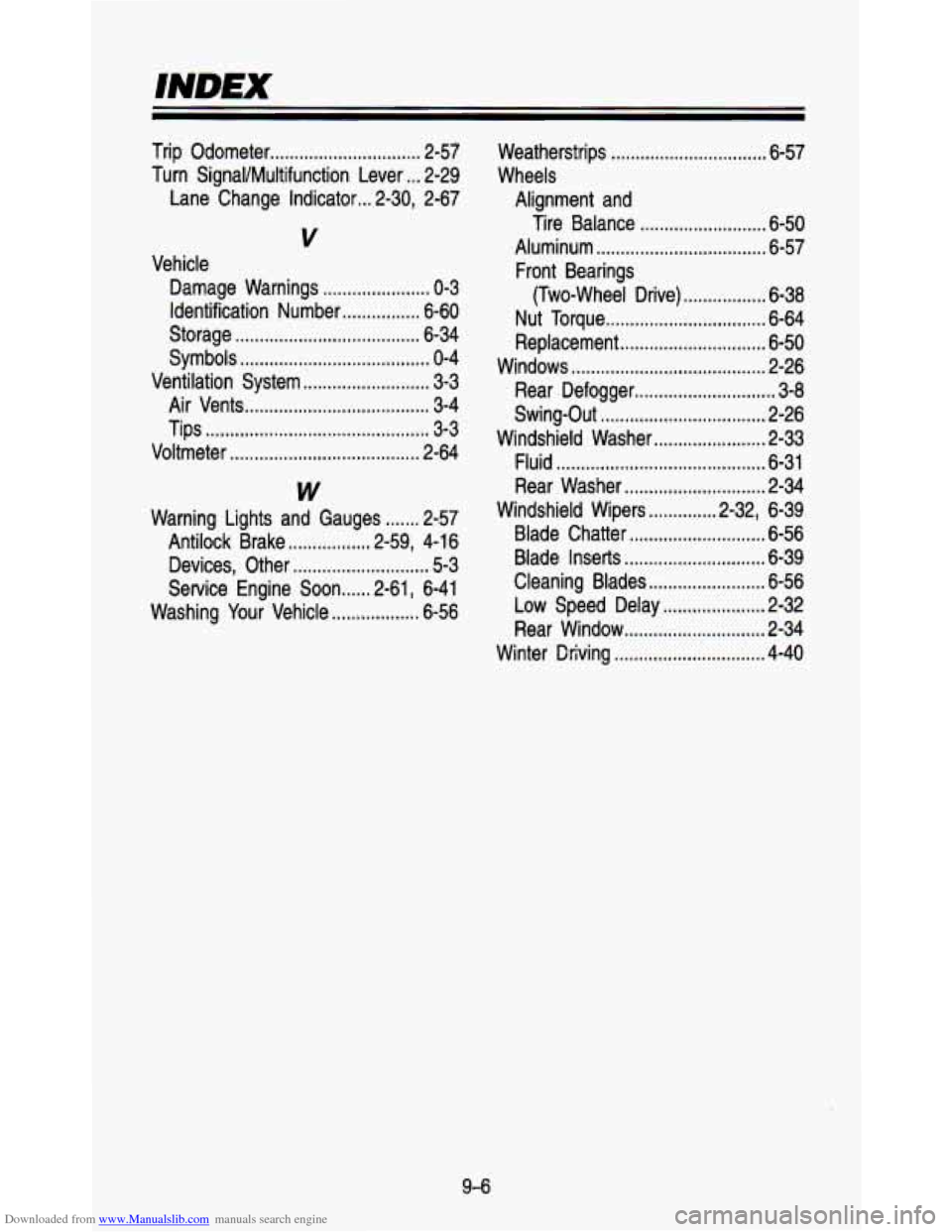
Downloaded from www.Manualslib.com manuals search engine INDEX
Trip Odometer ............................... 2-57
Turn SignaVMultifunction Lever
... 2-29
Lane Change Indicator
.. .2-30, 2-67
V
Damage Warnings ...................... 0-3
Identification Number
................ 6-60
Storage
...................................... 6-34
Symbols
...................................... -0-4
Ventilation System
.......................... 3-3
Air Vents
...................................... 3-4
Tips
.............................................. 3-3
Voltmeter
....................................... 2-64
W
Warning Lights and Gauges ....... 2-57
Antilock Brake
................. 2-59, 4-16
Devices, Other
............................ 5-3
Washing Your Vehicle
.................. 6-56
Vehicle
Service Engine Soon
...... 2-61, 6-41 Weatherstrips
................................ 6-57
Wheels Alignment and Tire Balance
.......................... 6-50
Aluminum
................................... 6-57
Front Bearings
Nut Torque
................................. 6-64
Replacement
.............................. 6-50
Windows
........................................ 2-26
Rear Defogger
............................. 3-8
Swing-Out
.................................. 2-26
Windshield Washer
....................... 2-33
Fluid
........................................... 6-31
Rear Washer
............................. 2-34
Windshield Wipers
.............. 2-32, 6-39
Blade Chatter
............................ 6-56
Blade Inserts
............................. 6-39
Cleaning Blades
........................ 6-56
Low Speed Delay
..................... 2-32
Rear Window
............................. 2-34
Winter Driving
............................... 4-40
(Two-Wheel Drive)
................. 6-38
9-6